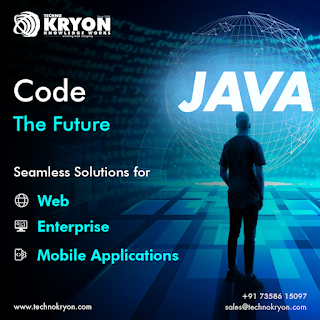Latest Trends in mobile app development
 | |||
| Techno Kryon |
1.
Wearable
Apps:
- User and system interact in a new way by wearable applications which is user-friendly and compact to use.
- It is easy to carry and are easily accessible which are always present and does its functionality. It does not need to be monitored always.
- User is updated with all new information and user response is got in lesser time, updated to the Host. It communicates with the host device through means of wireless communication.
- Only necessary data is shown and user response is received. Can monitor other services like location and health data of the user
- Wearable application use artificial intelligence algorithms and augmented reality technology to enhance user experience. Augmented reality can further be used to expand navigations on maps, health-related data, and improvise voice commands.
2. Artificial
Intelligence:
- AI is capable of finishing complex repeated processes that will be excessive overwork job for the users.
- AI will not produce any errors and any wrong data that will terminate the whole process. It is essential in the areas that require a high level of accuracy and exactness.
- AI implements ML (Machine Learning) procedure where the AI systems observe the user data, behavioural patterns such as location, favourite websites, etc... And can give matching results to the user according to the needs.
3. Cloud Computing:
- Applications cannot be executed on multiple devices for this issue cloud computing is used.
- It enables the developers to build mobile applications which have a different operating system (iOS/Android) or its capacity to store data.
- Cloud storage enables the user to store and manage their data by fast data synchronization between the devices and any other desktop or device chosen by the user.
- Data Security is maintained in the cloud by Firewall, user data are encrypted to maintain the privacy.
4. Block Chain :
- It consists of a distributed database, which transmits data via networked computers and set up the coordination by passing the message. The information either gets coded in middle of occurrences of the application or it uses a shared memory.
- Transactions must be done through a legal channel such as government bureau. Payment through bank accounts is an example. The Blockchain is free from government control and regulations.
- It is used to record transactions across many system nodes so that the record cannot be altered without modifying all consecutive blocks and the network. This allows the participants to verify and audit transactions reasonably.
5. Mobile Payment:
- Refers to payment services. It Uses WAP (Wireless Application Protocol) as the underlying technology.
- Each transaction include SSL certificates which secure the transmission via a gateway accessible only by the receiver.
There are many ways
mobile payment is done,
1) Contactless payment
for in-person transactions through a mobile phone (such as Apple Pay or Google
Pay).
2) Premium-rate
telephone numbers, which apply charges to the consumer's long-distance bill
3) Mobile-Operator
Billing allows charges to be added to the consumer's mobile telephone bill,
including deductions to prepaid calling plans
4) Credit cards and
debit cards
5) Micropayment services
Credit and debit cards
stored in a device, often used with mobile application stores or music stores
(example - Google Play).
6. Security:
- QA(Quality Assurance) is an important part of building secure code. It shouldn't simply be altered on to the end of the process. The code is reviewed constantly and identified for loopholes.
- Tokens are used to handle user logins and manage user sessions. A token can be easily revoked to ensure user security, but they're also more user-friendly, which is always a plus for an application.
- OAuth2, OpenID Connect, and JSON Web Tokens are all best methods for securing, simplifying user logins.
- VPN (Virtual private network), SSL (Secure Sockets Layer), and TLS(Transport Layer Security) can all help secure data in transition, it can encrypt it between sender and receiver. It ensures whether transmitting and receiving data is secure so it can't be intercepted or spoofed. Personal data stored by an app is vulnerable to remove the data, or move it to a secure location on the device or encrypt the data.
- Minimize permissions to reduce the risk of accessing other services. Reduce the usage of third-party dependencies which cannot be trusted.
7. Location-based
services:
- LBS uses real-time geographical data from devices to provide the required service. Some of the services in LBS are Google maps, Facebook which provides information according to the region where the user is present.
- Prevention of fraud - LBS creates a higher level of security by identifying customer’s location through the device to a credit card transaction. Binding the device location to a credit card allows us to mark transactions made across several geographic locations over a short time.
- Device usage in a workplace - companies that employ individuals out in the field or at multiple locations, LBS allows employees to check in at a location using their mobile device.
- Many companies specialize in contact with mobile wireless carriers to connect companies with smartphone user locations. These companies provide the required tool to connect with the most devices on the market and increase user interaction.
8. In-App Search:
- Users can search the contents within the apps on the device developers specify which data can be searched by the user outside the app. Google Android search and Apple Siri search suggestions are the best examples of in-app search.
- User can identify data in all apps and its scope, usage at the same time and move to the particular location in the application.



Comments
Post a Comment